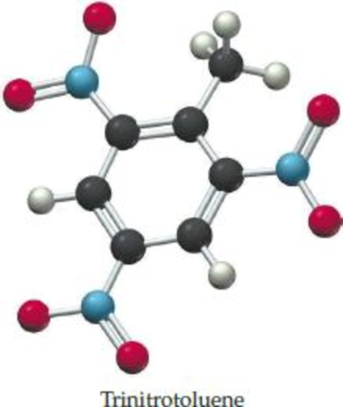
The explosion of 2.00 mol of solid trinitrotoluene (TNT; C7H5N3O6) with a volume of approximately 274 mL produces gases with a volume of 448 L at room temperature and 1.0 atm pressure. How much PV work in kilojoules is done during the explosion?

Want to see the full answer?
Check out a sample textbook solution
Chapter 8 Solutions
General Chemistry: Atoms First
- When lightning strikes, the energy can force atmospheric nitrogen and oxygen to react to make NO: N2(g)+O2(g)2NO(g)H=+181.8kJ (a) Is this reaction endothermic or exothermic? (b) What quantities of reactants and products are assumed if H = +181.8 kJ? (c) What is the enthalpy change when 3.50 g nitrogen is reacted with excess O2(g)?arrow_forwardHow many L atm are equal to 12.2 kJ of work?arrow_forwardHow many kJ are equal to 3.27 L atm of work?arrow_forward
- A piece of lead of mass 121.6 g was heated by an electrical coil. From the resistance of the coil, the current, and the Time the current flowed, it was calculated that 235 J of heat was added to the lead. The temperature of the lead rose from 20.4C to 35.5C. What is the specific heat of the lead?arrow_forward9.12 PV-work occurs when volume changes and pressure remains constant. If volume is held constant, can PV-work be done? What happens to Equation 9.2 when volume is held constant? E=q+w (9.2)arrow_forwardWhen solid iron burns in oxygen gas (at constant pressure) to produce Fe2O3(s), 1651 kJ of heat is released for every 4 mol of iron burned. How much heat is released when 10.3 g Fe2O3(s) is produced (at constant pressure)? What additional information would you need to calculate the heat released to produce this much Fe2O3(s) if you burned iron in ozone gas, O3(g), instead of O2(g)?arrow_forward
- Shown below is a diagram depicting the enthalpy change of a chemical reaction run at constant pressure. a Is the reaction exothermic or endothermic? b What is the sign of H? c What is the sign of q? d If the reaction does no work, what is the sign of E for this process?arrow_forwardConsider the following cyclic process carried out in two steps on a gas: Step 1: 45 J of heat is added to the gas, and 10. J of expansion work is performed. Step 2: 60. J of heat is removed from the gas as the gas is compressed back to the initial state. Calculate the work for the gas compression in Step 2.arrow_forwardA rebreathing gas mask contains potassium superoxide, KO2, which reacts with moisture in the breath to give oxygen. 4KO2(s)+2H2O(l)4KOH(s)+3O2(g) Estimate the grams of potassium superoxide required to supply a persons oxygen needs for one hour. Assume a person requires 1.00 102 kcal of energy for this time period. Further assume that this energy can be equated to the heat of combustion of a quantity of glucose, C6H12O6, to CO2(g) and H2O(l). From the amount of glucose required to give 1.00 102 kcal of heat, calculate the amount of oxygen consumed and hence the amount of KO2 required. The ff0 for glucose(s) is 1273 kJ/mol.arrow_forward
- Niagara Falls has a height of 167 ft (American Falls). What is the potential energy in joules of 1.00 lb of water at the top of the falls if we take water at the bottom to have a potential energy of zero? What would be the speed of this water at the bottom of the falls if we neglect friction during the descent of the water?arrow_forwardWhat mass of acetylene, C2H2(g), must be burned to produce 3420 kJ of heat, given that its enthalpy of combustion is 1301 kJ/mol? Compare this with the answer to Exercise 5.91 and determine which substance produces more heat per gram.arrow_forwardConsider the following reaction in a vessel with a movable piston. R(g)+T(g)X(g)As the reaction takes place, the piston loses 1072 J of heat. The piston moves down and the surroundings do 549 J of work on the system. What is E?arrow_forward
 General Chemistry - Standalone book (MindTap Cour...ChemistryISBN:9781305580343Author:Steven D. Gammon, Ebbing, Darrell Ebbing, Steven D., Darrell; Gammon, Darrell Ebbing; Steven D. Gammon, Darrell D.; Gammon, Ebbing; Steven D. Gammon; DarrellPublisher:Cengage Learning
General Chemistry - Standalone book (MindTap Cour...ChemistryISBN:9781305580343Author:Steven D. Gammon, Ebbing, Darrell Ebbing, Steven D., Darrell; Gammon, Darrell Ebbing; Steven D. Gammon, Darrell D.; Gammon, Ebbing; Steven D. Gammon; DarrellPublisher:Cengage Learning Chemistry: Principles and PracticeChemistryISBN:9780534420123Author:Daniel L. Reger, Scott R. Goode, David W. Ball, Edward MercerPublisher:Cengage Learning
Chemistry: Principles and PracticeChemistryISBN:9780534420123Author:Daniel L. Reger, Scott R. Goode, David W. Ball, Edward MercerPublisher:Cengage Learning Living By Chemistry: First Edition TextbookChemistryISBN:9781559539418Author:Angelica StacyPublisher:MAC HIGHER
Living By Chemistry: First Edition TextbookChemistryISBN:9781559539418Author:Angelica StacyPublisher:MAC HIGHER Chemistry & Chemical ReactivityChemistryISBN:9781133949640Author:John C. Kotz, Paul M. Treichel, John Townsend, David TreichelPublisher:Cengage Learning
Chemistry & Chemical ReactivityChemistryISBN:9781133949640Author:John C. Kotz, Paul M. Treichel, John Townsend, David TreichelPublisher:Cengage Learning Chemistry & Chemical ReactivityChemistryISBN:9781337399074Author:John C. Kotz, Paul M. Treichel, John Townsend, David TreichelPublisher:Cengage Learning
Chemistry & Chemical ReactivityChemistryISBN:9781337399074Author:John C. Kotz, Paul M. Treichel, John Townsend, David TreichelPublisher:Cengage Learning Chemistry: The Molecular ScienceChemistryISBN:9781285199047Author:John W. Moore, Conrad L. StanitskiPublisher:Cengage Learning
Chemistry: The Molecular ScienceChemistryISBN:9781285199047Author:John W. Moore, Conrad L. StanitskiPublisher:Cengage Learning





